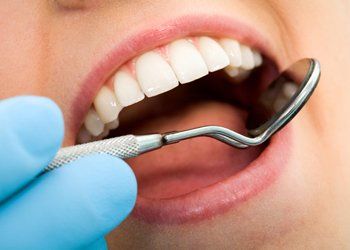EFFECTIVE DENTAL FILLINGS, CROWNS & IMPLANTS
AMALGAM VERSUS COMPOSITE FILLINGS

We have received numerous inquiries from patients concerning the type of filling material to be placed in their mouth. To clear any questions that may be concerning you, please review the following information.
Fillings should be placed in teeth that have sufficient tooth structure to support the filling material (small to moderate percentage of tooth is missing). In small to moderate size areas, either amalgam (silver) or composite (white) filling material will be adequate for multiple years. If the amount of tooth structure is large, then the tooth needs something stronger (like a crown or onlay-see below). So for smaller areas, the question is whether one material is better/safer than the other. The answer has been debated for many years. Currently, the American Dental Association has stated that amalgam (silver) fillings are safe to use in the general population, unless there is some type of metal allergy present. (visit www.ADA.org/en/about-the-ada/ada-positions-policie... for further information). However, composite (white) fillings have increased in popularity because they are tooth colored and have some added strength of "bonding" tooth structure compared with silver fillings. Other countries in Europe and Asia, for example, have eliminated the use of silver fillings to try and minimize the amount of mercury in the environment.
Fillings should be placed in teeth that have sufficient tooth structure to support the filling material (small to moderate percentage of tooth is missing). In small to moderate size areas, either amalgam (silver) or composite (white) filling material will be adequate for multiple years. If the amount of tooth structure is large, then the tooth needs something stronger (like a crown or onlay-see below). So for smaller areas, the question is whether one material is better/safer than the other. The answer has been debated for many years. Currently, the American Dental Association has stated that amalgam (silver) fillings are safe to use in the general population, unless there is some type of metal allergy present. (visit www.ADA.org/en/about-the-ada/ada-positions-policie... for further information). However, composite (white) fillings have increased in popularity because they are tooth colored and have some added strength of "bonding" tooth structure compared with silver fillings. Other countries in Europe and Asia, for example, have eliminated the use of silver fillings to try and minimize the amount of mercury in the environment.
CROWN PROCEDURE

Your teeth can require crowns for various reasons like: fracture, decay, large and weak fillings, discoloration, esthetics's and root canals. A crown is placed over a tooth and therefore, a certain amount of the original tooth must be removed to provide space for the crown to restore the tooth to its proper size and shape.
Placement of a crown generally requires 2 appointments. During the first appointment, the tooth is shaved down to create the ideal space for the new crown. A mold is made of this prepared tooth and a plastic temporary crown is placed until the next appointment. Using the mold, a dental laboratory will fabricate the final crown to the proper size, shape and color. During the second appointment, the crown is fitted on the tooth, the color is verified and the bite is adjusted. Once these steps have been completed, the crown is cemented over the prepared tooth.
Placement of a crown generally requires 2 appointments. During the first appointment, the tooth is shaved down to create the ideal space for the new crown. A mold is made of this prepared tooth and a plastic temporary crown is placed until the next appointment. Using the mold, a dental laboratory will fabricate the final crown to the proper size, shape and color. During the second appointment, the crown is fitted on the tooth, the color is verified and the bite is adjusted. Once these steps have been completed, the crown is cemented over the prepared tooth.
NATURAL TOOTH VERSUS IMPLANT

An implant is used to replace the root of a missing tooth. The root of the tooth is fixed in the jawbone and the top of the natural tooth has been prepared to receive a crown. Similarly, the implant is fixed within the jawbone and replaces the root of the natural tooth. The post attached to the implant is similar to the top of the prepared tooth. It too, is ready to receive a crown.
The process of making a crown on a natural tooth and an implant is very similar. Impressions are required of the mouth and models are made, upon which the crowns are fabricated. Crowns on natural teeth or implants can be made of metal and/or porcelain, and are fabricated to replace the size, shape and color of natural teeth. The implant is either screwed or cemented in place. An implant-supported crown is almost like having your natural tooth back!
The process of making a crown on a natural tooth and an implant is very similar. Impressions are required of the mouth and models are made, upon which the crowns are fabricated. Crowns on natural teeth or implants can be made of metal and/or porcelain, and are fabricated to replace the size, shape and color of natural teeth. The implant is either screwed or cemented in place. An implant-supported crown is almost like having your natural tooth back!
Contact us in Tewksbury, Massachusetts, to learn more about amalgam and composite dental fillings.
 381 Main St, Tewksbury MA 01876
381 Main St, Tewksbury MA 01876



 978-640-1117
978-640-1117



 381 Main St, Tewksbury MA 01876
381 Main St, Tewksbury MA 01876
 978-640-1117
978-640-1117



